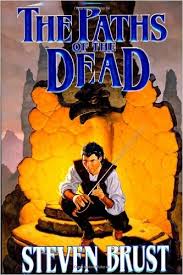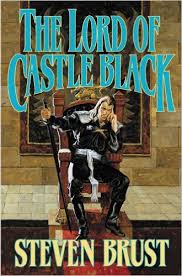 An interregnum is a time of confusion. It’s also a time of opportunity. With all political and magical systems suspended, anything can happen. It’s a perfect time to be young, and Piro, Zerika, Ibronka, Kytraan, Röaana and Morrolan are young. Of course, when you’re a Dragaeran, young means you’re under 500 years old.
An interregnum is a time of confusion. It’s also a time of opportunity. With all political and magical systems suspended, anything can happen. It’s a perfect time to be young, and Piro, Zerika, Ibronka, Kytraan, Röaana and Morrolan are young. Of course, when you’re a Dragaeran, young means you’re under 500 years old.
The Dragaerans are a magical race of beings who live thousands of years. They fall into seventeen Houses (one for peasants), each of which rules the Dragaeran Empire for a time, according to the structure of the Cycle. At least, that’s how it was until Adron’s Disaster, at which time the Orb disappeared, Dragaera City was swallowed by chaos, and the Empire dissolved into the Interregnum.
The Paths of the Dead opens with Piro (who is the Viscount of Adrilankha himself) being called to adventure by Sethra Lavode, the enchantress of Dzur Mountain. It seems that, at the time of Adron’s Disaster, the Cycle was in the House of the Phoenix. Since the Cycle was halted, the House of the Phoenix is still the ruling House. Unfortunately, all of that house were killed in the Disaster. Or were they? Piro and his new friend Kytraan (and their loyal servants) must help the remaining young Phoenix — now the heir — recover the Orb and restore the Empire.
In The Lord of Castle Black, Piro and company are thwarted in their aims by an upstart Dragonlord who seeks to take advantage of the Interregnum and refound the Empire with himself as the Emperor. But help is at hand. For Piro’s father, Khaavren, was alive several hundred years earlier — in fact he guarded the previous Emperor. With the help of other old friends, Khaavren comes out of grieving retirement to set things right.
 And then another Dragonlord strides onto the set. He’s Morrolan; raised among the Easterners, he has learned their magic, but is now returning to take his place in Dragaera as the Lord of Castle Black. He agrees to help Sethra Lavode, Piro et al. in their struggle to restart the Cycle and restore the authority of the Orb.
And then another Dragonlord strides onto the set. He’s Morrolan; raised among the Easterners, he has learned their magic, but is now returning to take his place in Dragaera as the Lord of Castle Black. He agrees to help Sethra Lavode, Piro et al. in their struggle to restart the Cycle and restore the authority of the Orb.
Steven Brust has been writing novels set in Dragaera for years. There are nine books about Vlad Taltos, an Easterner who lives among the Dragaerans as an assassin (a thousand or so years after the events in the series at hand). And there are two Khaavren Romances, featuring the exploits of the Khaavren mentioned above, when he was in the full flush of his youth, serving in The Phoenix Guards, and again Five Hundred Years After. Readers who have been following the adventures of Vlad Taltos and Khaavren will delight in the chance this new series offers to catch up with old friends. It fills in the blanks about such things as the mysterious origins of Morrolan, the Lord of Castle Black, who befriends Vlad Taltos. And, much like The Four Musketeers, it gives us a chance to see how aging heroes like Khaavren and his friends return to the world of action.
I must, however, offer a word of warning. In the Preface to The Paths of the Dead, the author says, “It is our firm hope that… readers will need no introduction other than this volume…” Vain hope. I had read no others of Brust’s Dragaera novels before this series, and it felt very much like starting in the middle of a story, with things going on all around me that I didn’t have a clue about. There are frequent references such as, “the reader will remember our dear friend So-and-so.” I didn’t remember him, and grew tired of wondering who he was.
Also, I found Brust’s writing style to be ponderous and distracting. For The Viscount of Adrilankha Adventures, Brust sets himself up as the translator of Sir Paarfi of Roundwood, a Dragaeran historian. Paarfi swathes the plot in layers and layers of elaborate prose, smothering the action. The dialogue is agonizingly drawn out by “translations” of idiomatic phrasing. An example:
“Hmmm,” said Pel.”But tell me,” said Khaavren, “what is this about a post working once more?”
“Oh, you wish to know that?”
“Yes, yes. In one thing I am not changed: I still have some curiosity. And you perceive that to have the post working once more, when for two hundred and fifty years there was none, well, it is like the sudden rising of the waves here on the coastline, in that it implies a great deal more activity than is at once visible.”
“Well, that is true.”
So, then, will you explain?”
“I should be glad to do so, this instant, if you wish.”
“I wish for nothing else in the world.”
This is rather clever if it happens once, or even occasionally. Even one character who always talks in this drawn-out way can be a clever sort of story element. But believe me, every character in these two books talks this way all the time! If I were not a reviewer, someone who is honor-bound by my noble profession to read every word of a book before venturing to review it, I would confess to you that I grew adept at mentally chopping off the first inch or so of text at the beginning of every conversation on a page.
Of course, my quibble with the writing style here is certainly a matter of preference. While to me it feels like a demented Dumas attempting to channel Sabatini, other readers have found it enjoyable. To be fair to Brust, I asked for opinions in the GMR break room, and a fellow reviewer said that she found Paarfi’s style “made her slow down to savour the words.” So there you go. In a further attempt to understand how someone who writes in mind-crushing strata of “asides” could have such a loyal following that he has written over a dozen novels on the strength of it, I went to my local public library and checked out a novel from his Vlad Taltos series at random. Yendi. Three pages in, I said to myself, “This man can write! Now I see how a person could get hooked on these books!” Writing from Vlad Taltos’ point of view, Brust uses a sparser, harder style, one much more to my taste.
It’s clear from the way The Paths of the Dead and The Lord of Castle Black are designed that many people, including other writers, are passionate lovers of Brust’s Dragaeran adventures. There are introductions, “scholarly notes” and reviews from such writers as Neil Gaiman, Emma Bull and Teresa Nielsen Hayden, all posing as Paarfi’s fellow scholars and contemporaries. These bits, slipped in at the opening and ending of each book, are just plain fun. If you’re a Brust fan, you won’t want to miss this new series. If you’re not already a Brust fan, I suggest you do as I’m about to do, and start with Vlad Taltos, which has already been reviewed by GMR.
(Tor, 2002 and 2003)
